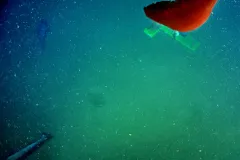Marine Snow: A Staple of the Deep


Snow on land can make some people grumpy, but the magical-looking flakes and a beautiful layer on the trees can turn even disenchanted adults into gleeful children again. But what is the ocean equivalent of a snowy night?
Our oceans do see ‘snow,’ but it is a very different beast underwater than the snow we see on land. The term ‘marine snow’ is used for all sorts of things in the ocean that start at the top or middle layers of water and slowly drift to the seafloor. This mostly includes waste, such as dead and decomposing animals, poop, silt and other organic items washed into the sea from land.
As this material drops deeper and deeper, the particles can grow in size as smaller flakes clump (the photo above from Richard Lampitt shows a 4mm clumb of marine snow). The larger size causes them to fall more quickly through the water column—but, even so, the journey to the bottom can take several weeks. Scientists have learned more about the travels of marine snow by using sediment traps on the ocean floor. Data from these traps have shown that 815 million tons of carbon reaches the ocean floor every year. These layers of ocean ooze are important carbon sinks—drawing down the decomposing bits of carbon, laying them to rest on the seafloor, and finally burying them.
 But not all particles get that far. They are often eaten by fish or marine mammals during their slow fall, just to be digested and pooped out elsewhere in the ocean to begin the cycle all over again. Once the trip is complete, this decomposing hodgepodge can be a welcome food source for animals in deep water and on the sea floor that don’t have reliable food in the sparse darkness. Some animals, such as the vampire squid, have special adaptations to help them better catch and eat the falling particles. The snow is also important to small, growing animals, such as eel larvae, which rely on the stuff for up to four months during their development. Marine snow clumps are also swarming with microbes—tiny organisms (tiny forms of life, ranging from algae to bacteria) form communities around the sinking particles. The photo (credit: H.P. Grossart) on the right shows an aggregate of marine snow covered in bacteria, which are the bright green spots.
But not all particles get that far. They are often eaten by fish or marine mammals during their slow fall, just to be digested and pooped out elsewhere in the ocean to begin the cycle all over again. Once the trip is complete, this decomposing hodgepodge can be a welcome food source for animals in deep water and on the sea floor that don’t have reliable food in the sparse darkness. Some animals, such as the vampire squid, have special adaptations to help them better catch and eat the falling particles. The snow is also important to small, growing animals, such as eel larvae, which rely on the stuff for up to four months during their development. Marine snow clumps are also swarming with microbes—tiny organisms (tiny forms of life, ranging from algae to bacteria) form communities around the sinking particles. The photo (credit: H.P. Grossart) on the right shows an aggregate of marine snow covered in bacteria, which are the bright green spots.
We still have much to learn about marine snow. But we do know already that though it may not be as pretty as snow on land, it’s a lot more nutritious!

